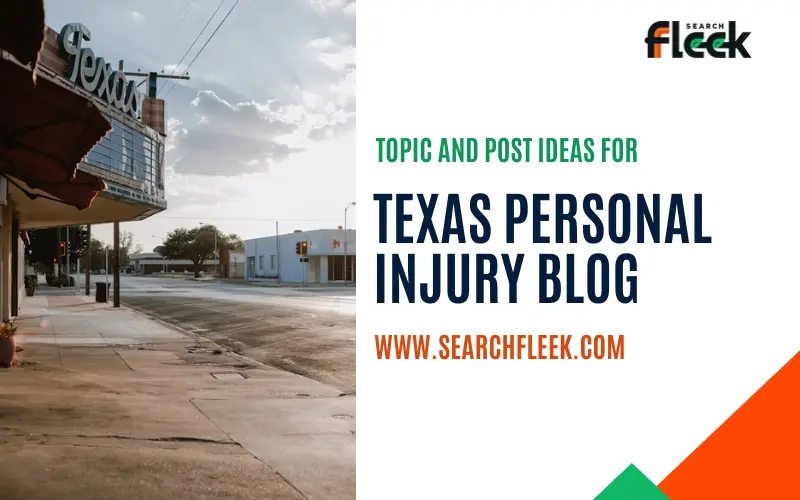Being injured in an accident can be a life-altering experience. The physical and emotional toll is immense, and navigating the legal landscape to seek compensation can feel overwhelming. Here at Search Fleek, we understand the importance of clear and concise information for personal injury victims in Texas.
This blog post provides 44 compelling blog topic ideas specifically tailored to Texas personal injury law. These topics will help you establish yourself as a knowledgeable and trustworthy resource for potential clients, ultimately attracting them to your legal practice.
44 Texas Personal Injury Blog Post Ideas:
- Car Accident Injuries in Texas: This broad topic can be further segmented into specific injuries like whiplash, broken bones, and traumatic brain injuries. Discuss the causes, symptoms, and legal options for car accident victims.
- Truck Accident Injuries in Texas: Large trucks pose a significant risk on Texas roads. Explore the unique challenges of truck accident claims and the importance of pursuing maximum compensation.
- Motorcycle Accident Injuries in Texas: Motorcyclists are especially vulnerable on the road. Address the specific laws and considerations for motorcycle accident claims in Texas.
- Pedestrian Accident Injuries in Texas: Pedestrian accidents can be devastating. Discuss the rights and legal options for pedestrians injured by vehicles in Texas.
- Premises Liability Injuries in Texas: Property owners have a duty to maintain a safe environment. Explore slip and fall accidents, swimming pool accidents, and other premises liability claims in Texas.
- Dog Bite Injuries in Texas: Dog bites can cause serious injuries. Discuss Texas’ dog bite laws, liability for dog owners, and compensation for victims.
- Wrongful Death Claims in Texas: Losing a loved one due to someone else’s negligence is tragic. Explain wrongful death claims in Texas, who can file them, and recoverable damages.
- Medical Malpractice Claims in Texas: When medical professionals make mistakes, it can have severe consequences. Discuss what constitutes medical malpractice in Texas and how to pursue a claim.
- Product Liability Claims in Texas: Defective products can cause serious injuries. Explore product liability laws in Texas and how to hold manufacturers accountable.
- What to Do After a Car Accident in Texas: Provide a step-by-step guide for car accident victims in Texas, including exchanging information, seeking medical attention, and contacting a lawyer.
- Texas Dram Shop Law: Explain how this law holds establishments liable for serving alcohol to intoxicated patrons who cause accidents.
- Head-On Collisions in Texas: Discuss the dangers and legal considerations specific to head-on collisions.
- Distracted Driving Accidents in Texas: Explore the dangers of distracted driving and legal options for victims of these accidents.
- DUI Accidents in Texas: Explain the legal consequences of DUI accidents and how to obtain compensation for injuries sustained.
- Uninsured/Underinsured Motorist Coverage in Texas: Discuss the importance of uninsured/underinsured motorist coverage and how it protects you in an accident.
- Shared Fault Laws in Texas: Explain Texas’ shared fault laws and how they impact personal injury claims.
- The Statute of Limitations for Personal Injury Claims in Texas: Inform potential clients about the deadlines for filing a personal injury lawsuit in Texas.
- Common Mistakes to Avoid After an Accident: Advise on actions to take and mistakes to avoid to protect your legal rights after an accident.
- Negotiating with Insurance Companies in Texas: Provide tips for negotiating a fair settlement with insurance companies after an accident.
- What to Expect During a Personal Injury Lawsuit in Texas: Demystify the legal process for personal injury lawsuits in Texas.
- Construction Site Accidents in Texas: Discuss the prevalence of construction site accidents and legal options for injured workers.
- Workplace Injuries in Texas: Explain workers’ compensation benefits and how to pursue additional compensation for serious workplace injuries.
- Oilfield Accidents in Texas: Explore the unique risks and legal considerations for oilfield workers injured on the job.
- Nursing Home Abuse and Neglect in Texas: Advocate for the rights of elderly victims of nursing home abuse and neglect.
- Boating Accidents in Texas: Address the specific laws and legal issues related to boating accidents in Texas.
- Bicycle Accident Injuries in Texas: Discuss the rights and legal options for cyclists injured in accidents.
- Brain Injuries in Texas: Explain the complexities of brain injuries and how to obtain compensation for these life-altering conditions.
- Spinal Cord Injuries in Texas: Discuss the devastating consequences of spinal cord injuries and the importance of securing experienced legal representation.
- Burn Injuries in Texas: Explore the treatment options and legal considerations for burn injury victims.
- Emotional Distress Damages in Texas Personal Injury Claims: Explain the types of emotional distress damages recoverable in personal injury lawsuits.
- How to Choose the Right Personal Injury Lawyer in Texas: Guide potential clients on selecting a qualified and experienced personal injury lawyer.
- The Benefits of Hiring a Personal Injury Lawyer in Texas: Highlight the advantages of working with a personal injury lawyer to navigate a personal injury claim.
- Personal Injury Damages Available in Texas: Break down the different types of damages recoverable in personal injury claims, such as medical expenses, lost wages, pain and suffering, and property damage.
- Maximizing Your Personal Injury Settlement in Texas: Offer tips for maximizing the value of your personal injury settlement.
- Can I File a Personal Injury Claim if I Was Partially at Fault in Texas?: Address the impact of shared fault on personal injury claims in Texas.
- Personal Injury Law for Immigrants in Texas: Provide resources and legal information for immigrants who have been injured in accidents in Texas.
- How Does Social Media Impact My Personal Injury Case in Texas?: Discuss the potential consequences of social media activity on your personal injury claim.
- Personal Injury Cases Involving Minors in Texas: Explain the legal considerations and processes involved in personal injury cases involving children.
- What to Do if Your Personal Injury Claim is Denied by the Insurance Company in Texas: Offer guidance on how to proceed if your insurance claim is denied.
- Alternative Dispute Resolution (ADR) for Personal Injury Claims in Texas: Explore alternative methods like mediation and arbitration for resolving personal injury disputes.
- Personal Injury Protection (PIP) Insurance in Texas: Explain the benefits and limitations of PIP insurance in Texas.
- Personal Injury Law for Veterans in Texas: Provide resources and legal information specifically for veterans injured in accidents.
- The Impact of COVID-19 on Personal Injury Law in Texas: Discuss how the pandemic has affected personal injury cases and legal proceedings.
- The Future of Personal Injury Law in Texas: Explore emerging trends and potential changes in Texas personal injury law.
Building Trust with Potential Clients
In the competitive world of personal injury law, establishing trust with potential clients is paramount. Here are some key strategies to incorporate into your Texas personal injury blog to build strong relationships and attract new clients:
Showcase Your Expertise:
Compose informative and well-written blog posts that demonstrate your in-depth knowledge of Texas personal injury law. Discuss recent legal developments, explain complex legal concepts in a clear and concise way, and reference relevant court cases.
Highlight Success Stories:
Share positive outcomes you’ve achieved for past clients. This builds trust and showcases your ability to deliver results. Be sure to maintain client confidentiality while highlighting successful resolutions.
Offer Free Consultations:
Let potential clients know you’re available to discuss their case in a free consultation. This demonstrates your willingness to help and allows you to assess their legal needs during a no-pressure conversation.
Be Approachable and Accessible:
Maintain a professional yet approachable tone in your blog posts. Avoid overly legal jargon and use clear, easy-to-understand language. Make it easy for potential clients to contact you by providing clear contact information on your website and blog.
By consistently implementing these strategies, you can build trust with potential clients and establish your personal injury law practice as a valuable resource in Texas.
Unveiling the Content Roadmap: Why SEO Research is Your Guide
Imagine navigating a dense forest without a map – frustrating, right? That’s what creating business blog content feels like without SEO research. In today’s digital landscape, a strategic blog fuels brand awareness, attracts new customers, and ultimately drives sales. But without proper research, your content can be lost in the digital wilderness, failing to reach its intended audience.
SEO Research: The Foundation of Your Content Strategy
Think of SEO research as the compass guiding you through the content creation jungle. By meticulously analyzing search trends and relevant keywords, you can identify the exact topics your ideal customers are actively searching for online. This empowers you to craft content that directly addresses their pain points and questions, positioning you as a trusted resource in your industry.
Keywords: Fueling Your Content Engine
Keyword research is the gasoline that propels your content forward. By using keyword research tools, you can discover high-performing keywords related to your niche. Integrating these keywords organically throughout your blog posts strengthens your website’s relevance in search engine algorithms. This translates to a higher ranking in search results, leading to increased organic traffic and brand visibility.
Content Planning: Charting Your Course to Success
Armed with your research (the compass) and keyword knowledge (the fuel), you can now develop a strategic content plan. This plan serves as your roadmap, guiding you in creating a consistent flow of valuable and engaging content. Imagine a well-planned content calendar as a GPS system, ensuring your website takes the right turns and reaches the targeted audience you seek.
Building Your Texas Personal Injury Blog
A well-structured and informative blog is a powerful tool for attracting potential clients in Texas. Here are some key steps to consider when building your Texas personal injury blog:
- Target Your Audience:
Before diving into specific blog topics, it’s crucial to understand your target audience. Who are you trying to reach? Are you focusing on a specific geographic area within Texas? Identifying your ideal client will inform the tone, language, and legal issues addressed in your blog posts.
- Focus on Local Issues:
People searching for a personal injury lawyer are often looking for someone familiar with the local legal landscape. Highlight relevant Texas statutes, court rulings, and legal trends in your blog posts.
- Address Common Concerns:
What questions do potential clients typically have? Many people are unsure of their legal rights after an accident. Address common concerns like:
- Do I have a case?
- How much is my case worth?
- What should I avoid saying to the insurance company?
- How long will my case take?
- Optimize for Search Engines (SEO):
Creating valuable content is essential, but ensuring it reaches your target audience is equally important. Utilize relevant keywords throughout your blog posts and meta descriptions. Conduct keyword research to identify search terms potential clients use to find personal injury lawyers in Texas.
- Incorporate Multimedia:
Break up text-heavy content with engaging visuals like infographics, photographs, and even videos.
- Maintain Consistency:
Regularly publish fresh content to keep your blog active and attract returning visitors. Aim for a consistent posting schedule, whether it’s weekly, bi-weekly, or monthly.
By following these steps and focusing on high-quality content targeted towards your ideal client, you can build a successful Texas personal injury blog that attracts potential clients and grows your practice.
FAQs for Texas Personal Injury Blog
If you’ve been injured due to someone else’s negligence and suffered damages (medical bills, lost wages, pain and suffering), you might have a case. It’s always best to consult with a personal injury lawyer to discuss the specifics of your situation.
Seek immediate medical attention, document the scene of the accident (photos, videos), and avoid discussing fault with anyone besides the police and your lawyer.
The statute of limitations for personal injury claims in Texas is generally two years from the date of the injury. However, it’s crucial to consult with a lawyer as soon as possible to ensure you meet all deadlines.
Common mistakes include: failing to seek medical attention, admitting fault at the scene, discussing the accident on social media, and talking to the insurance company without legal representation.
Many personal injury lawyers work on a contingency fee basis, meaning they only get paid if they win your case. Their fee is typically a percentage of the settlement or verdict you receive.
Conclusion
Being injured in an accident can be a stressful and overwhelming experience. A well-informed personal injury blog can be a valuable resource for Texans navigating the legal process. By implementing the strategies outlined in this blog post, you can create a Texas personal injury blog that attracts potential clients, establishes your expertise, and positions your law practice for success.
Ever Written a Blog Post That Feels Like a Detour on the Road to SEO Success? A well-defined content outline prevents this navigational error. It acts as your GPS, ensuring your post stays on the right track, incorporates relevant keywords seamlessly, and ultimately delivers a clear and informative piece that drives organic traffic and improves your SEO ranking. Invest in an outline – it’s the roadmap to SEO mastery!
Remember, this blog post provides general information and shouldn’t be considered legal advice. For specific guidance on your situation, consult with a qualified Texas personal injury lawyer.
Emon Anam, CEO of Search Fleek, isn't your typical digital guru. He brings a unique blend of financial expertise (former banking pro!) and digital marketing mastery to the table. A self-proclaimed "SEO Sherlock Holmes," Emon unlocks content secrets for local businesses and SaaS companies. But beyond the keyboard, he's a devoted family man, music enthusiast, and cricket champion. Let Emon weave your digital success story!




